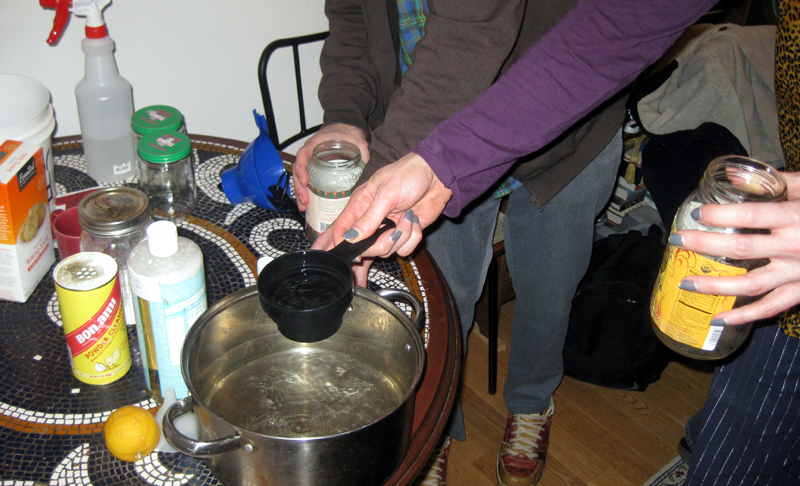
On Saturday, March 2, 2013, Heather McCann and I had a workshop at my house about DIY home cleaners-- nontoxic, cheap, and environmentally-friendly cleaners you can make yourself. We called it a "green cleaning party," and invited about 10 people over.
Heather and I did research, and presented a number of recipes that were alternatives to the products you can buy in the store.
We also led discussions on why it can be better for your health, and the health of the environment, to make your own. Not to mention easier on the wallet!
Below are some recipes we used.
Learn more
The handout Heather made for the skillshare. It includes pictures of chickens.
Amy Kolb Noyes. "Nontoxic housecleaning." White River Junction VT: Chelsea Green Guides. 2009.
Raleigh Briggs. "Make your place: affordable, sustainable nesting skills." Portland OR: Microcosm. 2009.
Recipes
All of the recipes included nontoxic materials that you can buy for cheap at the grocery store-- although some of them are only available at certain grocery stores.
Heather and I talked about the pros and cons of using Borax. Borax is an ingredient in dozens of DIY cleaners, and a lot of people swear by it. Some older studies suggest there might be issues with using it--but these studies aren't conclusive.
-1 tsp liquid Castile soap
-A few drops each Eucalyptus and lavender essential oil
-3 drops tea tree oil
-2 cups hot (not boiling) water
Mix all ingredients together in a spray bottle. You can use this on anything besides glass. Spray it on, scrub, and rinse off with a clean, damp cloth.
(Adapted from Make Your Place by Raleigh Briggs)
Heather's note: It didn't seem necessary to rinse this. It evaporated without leaving surfaces sticky. This originally called for two T white vinegar, which is how I originally made it. I've seen an article that suggests leaving the vinegar out or possibly rinsing with a vinegar-dampened cloth.
-1 cup water
-1 cup white vinegar
-A few drops of lemon oil or lemon juice
Combine all ingredients in a spray bottle. Shake well before using.
(Adapted from Make Your Place by Raleigh Briggs)
-1 cup baking soda
-1 cup vinegar
Add baking soda and vinegar to a pot of boiled water and pour down the drain, then flush with tap water.
For more stubborn clogs, use a "snake" plumbing tool to manually remove blockage, or try suction removal with a plunger.
To prevent clogs, install inexpensive mesh screen, available at home improvement and hardware stores.
(from the National Resources Defense Council)
Tim's note: Dump the vinegar in first. Then, position your pot in the tub right next to the drain before you add the baking soda, . Because... once you add the baking soda, you're gonna have a lot of fizzes.
-1 part distilled white vinegar
-1 part dish soap
Heat the vinegar until it's hot (but not enough that it would melt the spray bottle!). Combine vinegar with the dish soap and put into a spray bottle. Mix well.
Spray the mixture onto the soap scum and let it sit for approximately 30 minutes and then use a plastic scrubber or non-scratching scrubber sponge to scrub at the mixture.
(This recipe is all over the web, but this particular version is from idreamofclean.net)
Tim's note: I found that you don't really need to let it sit for 30 minutes. Even just 10 will do.